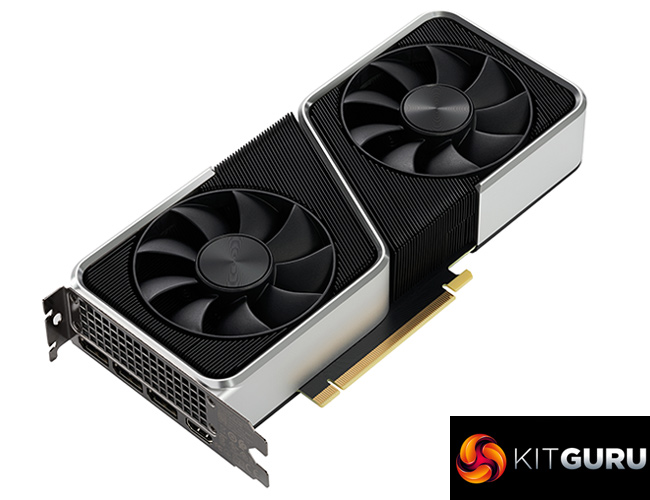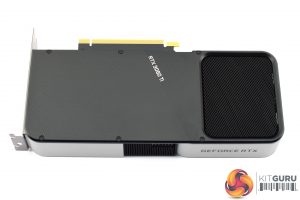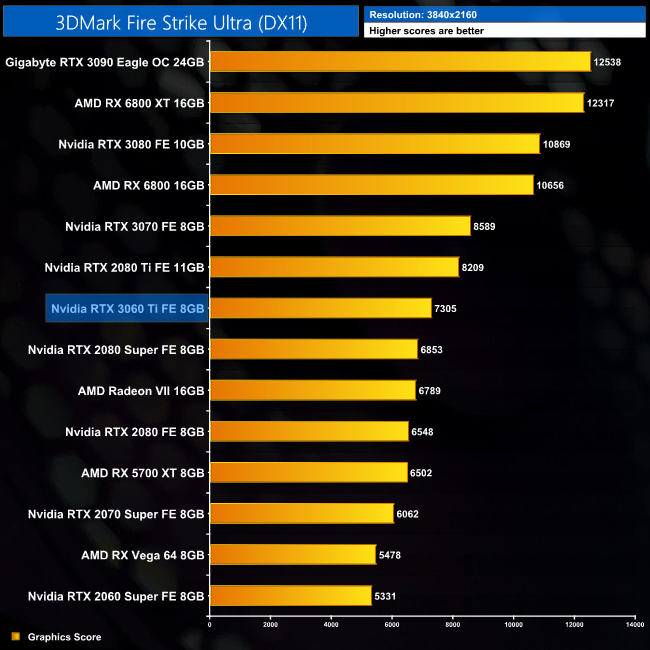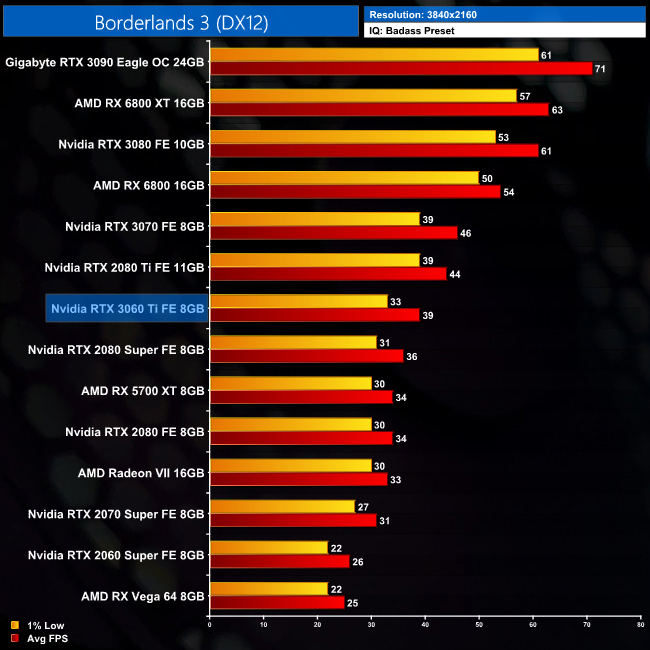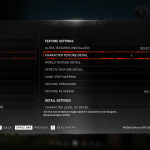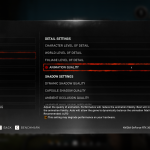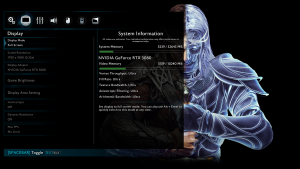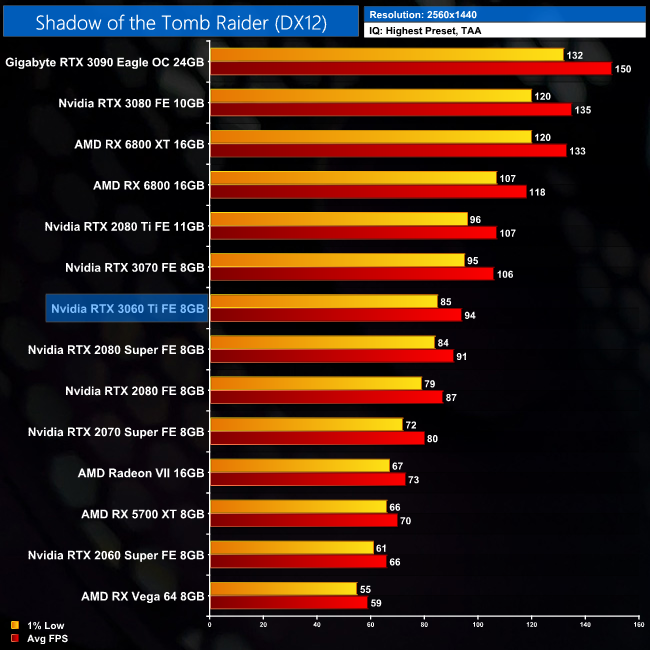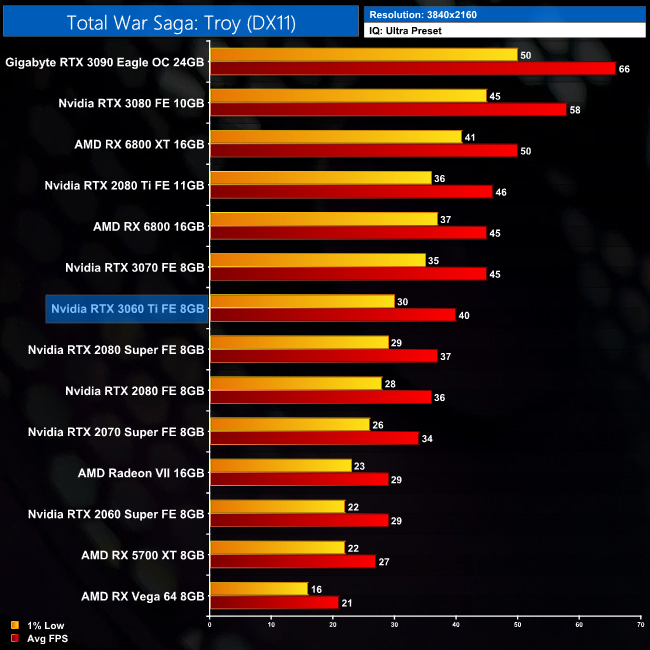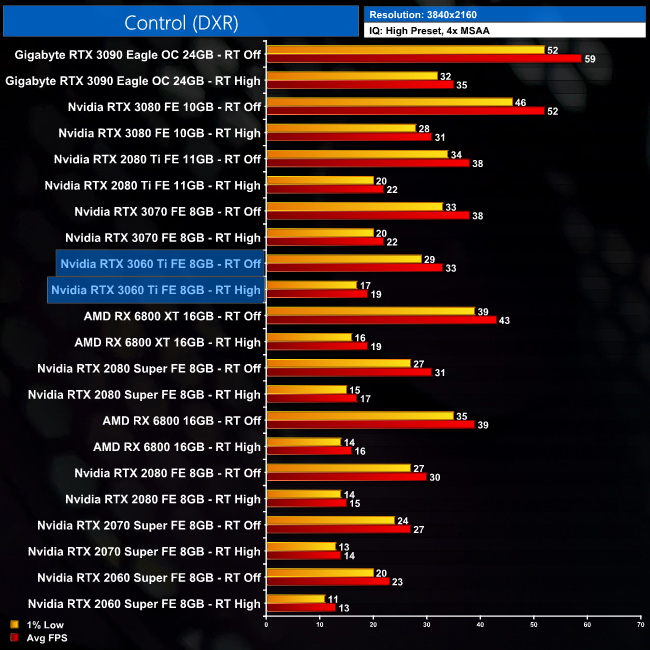
Claimed to be faster than the RTX 2080 Super, today marks the launch of Nvidia's latest Ampere GPU, the RTX 3060 Ti. Priced at £369 here in the UK, the RTX 3060 Ti is the next step down in the 30-series stack, bringing Ampere to its lowest price point yet. Using a cut-down version of the RTX 3070 GPU, it looks tailor-made for a high refresh-rate 1080p or 1440p display, so let's see exactly what this new GPU can deliver.
There's been a succession of GPU launches over the past couple of months, but for the most part the focus has been on the high-end segment – those willing to spend upwards of £500 (or significantly more!) for a new graphics card. With the RTX 3060 Ti, Nvidia is bringing its latest Ampere GPU down into the mid-range, with the MSRP set to £369 here in the UK.
That's exactly £300 less than what the RTX 2080 Super launched for just last year, yet Nvidia isn't shy about claiming the RTX 3060 Ti is the faster GPU. We're also told to expect an uplift of 40% compared to the RTX 2060 Super, which itself launched for £379 in July 2019. Here, we put both claims to the test, looking at 1080p, 1440p and 4K performance over a range of AAA games.
| GPU | RTX 3090 | RTX 3080 | RTX 3070 | RTX 3060 Ti | RTX 2080 SUPER |
| SMs | 82 | 68 | 46 | 38 | 48 |
| CUDA Cores | 10496 | 8704 | 5888 | 4864 | 3072 |
| Tensor Cores | 328 | 272 | 184 | 152 | 384 |
| RT Cores | 82 | 68 | 46 | 38 | 48 |
| Texture Units | 328 | 272 | 184 | 152 | 192 |
| ROPs | 112 | 96 | 96 | 80 | 64 |
| GPU Boost Clock | 1695 MHz | 1710 MHz | 1725 MHz | 1665 MHz | 1815 MHz |
| Memory Data Rate | 19.5 Gbps | 19 Gbps | 14 Gbps | 14 Gbps | 15.5 Gbps |
| Total Video Memory | 24GB GDDR6X | 10GB GDDR6X | 8GB GDDR6 | 8GB GDDR6 | 8GB GDDR6 |
| Memory Interface | 384-bit | 320-bit | 256-bit | 256-bit | 256-bit |
| Memory Bandwidth | 936 GB/Sec | 760 GB/Sec | 448 GB/Sec | 448 GB/Sec | 496.1 GB/sec |
| TGP | 350W | 320W | 220W | 200W | 250W |
The RTX 3060 Ti is the first Ampere GPU to launch which wasn't announced in the September livestream event. Just like the RTX 3070, however, it uses Nvidia’s GA104 GPU, but a cut-down version of that silicon. That means the RTX 3060 Ti incorporates 38 Streaming Multiprocessors (SMs), and thanks to Ampere’s new SM structure with its two FP32 datapaths, each SM houses 128 CUDA cores, giving a total of 4684.
Ampere also places one RT core, and four Tensor cores, in each SM, giving a total of 38 RT cores and 152 Tensor cores. This is accompanied by 152 texture units, and 80 ROPs which are now housed directly within each graphics processing cluster (GPC), with 16 ROPs per GPC, and 5 GPCs in total for RTX 3070.
Clock speed is slightly lower than the RTX 3070. The RTX 3070 Founders Edition has a reference clock of 1725MHz, but the RTX 3060 Ti drops that down to 1665MHz. We test real-world clock speed behaviour later in this review.
For the memory, Nvidia is using the same configuration as the RTX 3070. That means it sports 8GB of 14Gbps GDDR6 memory, operating over a 256-bit bus, for total memory bandwidth of 448 GB/Sec. My particular Founders Edition model uses Samsung G6 memory, but we have also seen Micron memory being used in the past.
Lastly, for total graphics power, Nvidia rates the RTX 3060 Ti for 200W, which is 20W less than the RTX 3070 as a result of its lower core-count and slightly reduced clock speed.
The RTX 3060 Ti Founders Edition ships in the same style of box we have seen from the other 30-series GPUs – it's almost entirely black, with some silver lines drawn on the front, with the GeForce branding visible in the top left corner.
On the back, Nvidia highlights various system specifications and product features.
Inside, we get the now-familiar array of accessoires, including a support guide, quick start guide, and an 8-pin to 12-pin power adapter.
Taking a look at the RTX 3060 Ti Founders Edition, the card itself is functionally identical to the RTX 3070 Founders Edition that we reviewed in late October. That means it's the same dual-fan approach, with both 85mm fans placed on the underside of the card (unlike the RTX 3080 Founders Edition), while the black aluminium fin stack is also clearly visible.
The only difference between the two cards is the RTX 3060 Ti has a silver shroud, compared to a more gunmetal grey colour used for the RTX 3070. Both look fantastic in my opinion and I couldn't imagine either looking out of place in any system build.
In terms of its dimensions, the 3060 Ti measures 242mm x 112mm, and it's a dual-slot thickness. Just like the RTX 3070, it's a very diminutive design.
The front side of the card is mostly just bare metal, but we can see the GeForce RTX branding towards the end of the card.
As for the backplate, it's the same design as the RTX 3070. That means it is left unmarked, apart from ‘RTX 3060 Ti' printed in small silver text. There's also a large cut-out to allow airflow from the right-side fan to pass straight through the heatsink and out into the chassis.
Once more, Nvidia is using its 12-pin connector for the RTX 3060 Ti Founders Edition, but we do not expect to see this on any AIB cards.
Display connectors consist of 3x DisplayPort 1.4a, and then 1x HDMI 2.1 capable of the full 48Gbps bandwidth.
Driver Notes
- All Nvidia GPUs (except RTX 3060 Ti) were benchmarked with the 457.09 driver.
- RTX 3060 Ti was benchmarked with the 457.40 driver supplied to press.
- All AMD GPUs (except RX 6000) were benchmarked with the Adrenalin 20.11.1 driver.
- RX 6800 and RX 6800 XT were benchmarked with the Adrenalin 20.45.12.1 driver supplied to press.
Test System
We test using the a custom built system from PCSpecialist, based on Intel's latest Comet Lake-S platform. You can read more about it over HERE, and configure your own system from PCSpecialist HERE.
| CPU |
Intel Core i9-10900K
Overclocked to 5.1GHz on all cores |
| Motherboard |
ASUS ROG Maximus XII Hero Wi-Fi
|
| Memory |
Corsair Vengeance DDR4 3600MHz (4 X 8GB)
CL 18-22-22-42
|
| Graphics Card |
Varies
|
| System Drive |
500GB Samsung 970 Evo Plus M.2
|
| Games Drive | 2TB Samsung 860 QVO 2.5″ SSD |
| Chassis | Fractal Meshify S2 Blackout Tempered Glass |
| CPU Cooler |
Corsair H115i RGB Platinum Hydro Series
|
| Power Supply |
Corsair 1200W HX Series Modular 80 Plus Platinum
|
| Operating System |
Windows 10 2004
|
Comparison Graphics Cards List
- Gigabyte RTX 3090 Eagle OC
- Nvidia RTX 3080 FE 10GB
- Nvidia RTX 3070 FE 8GB
- Nvidia RTX 2080 Ti FE 11GB
- Nvidia RTX 2080 Super FE 8GB
- Nvidia RTX 2080 FE 8GB
- Nvidia RTX 2070 Super FE 8GB
- Nvidia RTX 2060 Super FE 8GB
- AMD RX 6800 XT 16GB
- AMD RX 6800 16GB
- AMD Radeon VII 16GB
- AMD RX 5700 XT 8GB
- AMD RX Vega 64 8GB
Software and Games List
- 3DMark Fire Strike & Fire Strike Ultra (DX11 Synthetic)
- 3DMark Time Spy (DX12 Synthetic)
- 3DMark Raytracing Feature Test (DXR Synthetic)
- Borderlands 3 (DX12)
- Control (DX12)
- Death Stranding (DX12)
- The Division 2 (DX12)
- F1 2020 (DX12)
- Far Cry New Dawn (DX11)
- Gears 5 (DX12)
- Ghost Recon: Breakpoint (Vulkan)
- Metro: Exodus (DX12)
- Middle Earth: Shadow of War (DX11)
- Red Dead Redemption 2 (Vulkan)
- Shadow of the Tomb Raider (DX12)
- Total War Saga: Troy (DX11)
- Watch Dogs: Legion (DX12)
We run each benchmark/game three times, and present mean averages in our graphs. We use OCAT to measure average frame rates as well as 1% low values across our three runs.
Fire Strike is a showcase DirectX 11 benchmark for modern gaming PCs. Its ambitious real-time graphics are rendered with detail and complexity far beyond other DirectX 11 benchmarks and games. Fire Strike includes two graphics tests, a physics test and a combined test that stresses the CPU and GPU. (UL).
3DMark Time Spy is a DirectX 12 benchmark test for Windows 10 gaming PCs. Time Spy is one of the first DirectX 12 apps to be built the right way from the ground up to fully realize the performance gains that the new API offers. With its pure DirectX 12 engine, which supports new API features like asynchronous compute, explicit multi-adapter, and multi-threading, Time Spy is the ideal test for benchmarking the latest graphics cards. (UL).
Starting our performance testing with 3DMark, across all three of our benchmarks we can see the RTX 3060 Ti living up to Nvidia's claim of being faster than the RTX 2080 Super. The differences aren't huge, but the Ampere GPU is 2% faster in Fire Strike and Time Spy, though this stretches to 7% in Fire Strike Ultra.
Real-time ray tracing is incredibly demanding. The latest graphics cards have dedicated hardware that’s optimized for ray-tracing. The 3DMark DirectX Raytracing feature test measures the performance of this dedicated hardware. Instead of using traditional rendering techniques, the whole scene is ray-traced and drawn in one pass. The result of the test depends entirely on ray-tracing performance. (UL).
Looking at pure ray tracing-only performance – with no rasterisation – sees the RTX 3060 Ti outpace even AMD's RX 6800 XT, which is impressive. The Ampere GPU is also 23% faster than the RTX 2080 Super here, and a whopping 77% faster than the RTX 2060 Super.
Borderlands 3 is an action role-playing first-person shooter video game developed by Gearbox Software and published by 2K Games. It is a sequel to 2012's Borderlands 2, and the fourth entry in the main Borderlands series. Borderlands 3 was released on 13 September 2019 for Microsoft Windows, PlayStation 4, Xbox One. (Wikipedia).
Engine: Unreal Engine 4. We test using the Badass preset, DX12 API.
For our games testing, we start with Borderlands 3. At 1080p, the RTX 3060 Ti delivers 97FPS on average, putting it 4% ahead of the RTX 2080 Super and 43% ahead of the RTX 2060 Super, so it's a good start for this new Ampere GPU.
Stepping up to 1440p, here the 3060 Ti only gets better, as it is 8% faster than the 2080 Super at this resolution. Compared to the 2060 Super, we're talking a margin of 46%.
Control is an action-adventure video game developed by Remedy Entertainment and published by 505 Games. Control was released on 27 August 2019 for Microsoft Windows, PlayStation 4, and Xbox One. (Wikipedia).
Engine: Northlight Engine. We test using the High preset, with 4x MSAA, DX12 API.
Next up is Control, one of the more demanding titles that we test, but at 1080p the RTX 3060 Ti is still able to deliver 100FPS on average, giving it a 2% lead over the RTX 2080 Super. It's also just 12% slower than the RTX 3070, despite being 21% cheaper.
Up at 1440p, the 3060 Ti still averages over 60FPS, remaining 2% faster than the 2080 Super, but 38% faster than the 2060 Super.
Death Stranding is an action game developed by Kojima Productions. It is the first game from director Hideo Kojima and Kojima Productions after their split from Konami in 2015. It was released by Sony Interactive Entertainment for the PlayStation 4 in November 2019 and by 505 Games for Windows in July 2020. (Wikipedia).
Engine: Decima. We test using the Very High preset, with TAA, DX12 API.
Moving on, Death Stranding is one of the least demanding games we test, and at 1080p the RTX 3060 Ti averages over 160FPS. Here, it is 4% faster than the RTX 2080 Super, but 29% faster than the 2060 Super, which is one of the smaller differences we will see today.
Increasing the resolution to 1440p does push the 3060 Ti ahead, as it is 35% faster than the 2060 Super. Notably, it's also just 10% behind the RTX 3070 which is pretty good going.
Tom Clancy's The Division 2 is an online action role-playing video game developed by Massive Entertainment and published by Ubisoft. The sequel to Tom Clancy's The Division (2016), it is set in a near-future Washington, D.C. in the aftermath of a smallpox pandemic, and follows an agent of the Strategic Homeland Division as they try to rebuild the city. (Wikipedia).
Engine: Snowdrop. We test using the Ultra preset, but with V-Sync disabled, DX12 API.
Next up we have The Division 2. We've noticed how this game seems to really like the Ampere architecture, and we can see the RTX 3060 Ti deliver gains of 44% over the RTX 2060 Super at 1080p, and that's the biggest difference between those GPUs we will see at this resolution.
Up at 1440p, the gap only widens, and the 3060 Ti is now 48% faster than the RTX 2060 Super. Compared to the 2080 Super, we're talking a margin of 5% in the 3060 Ti's favour.
F1 2020 is the official video game of the 2020 Formula 1 and Formula 2 Championships developed and published by Codemasters. It is the thirteenth title in the Formula 1 series developed by the studio and was released on 7 July 2020 for pre-orders of the Michael Schumacher Edition and 10 July 2020 for the Seventy Edition on Microsoft Windows, PlayStation 4, Xbox One. (Wikipedia).
Engine: EGO. We test using the Ultra High preset, DX12 API.
Now we come to F1 2020. This is another game where the 3060 Ti does well, delivering over 170FPS at 1080p. This gives it a 4% lead over the RTX 2080 Super, but a 37% lead over the 2060 Super.
As for 1440p, things only get better here. First of all, the frame rate of almost 140FPS is impressive, but it's also 5% faster than the 2080 Super and now 44% faster than the 2060 Super, which isn't bad at all.
Far Cry New Dawn is an action-adventure first-person shooter developed by Ubisoft Montreal and published by Ubisoft. The game is a spin-off of the Far Cry series and a narrative sequel to Far Cry 5. It was released for Microsoft Windows, PlayStation 4 and Xbox One on February 15, 2019. (Wikipedia).
Engine: Dunia 2. We test using the Ultra preset, with the HD Textures pack, DX11 API.
Now we come to Far Cry New Dawn, and due to a CPU-limitedness issue at 1080p, the results aren't all that useful. The 3060 Ti is only delivering 17% better performance than the 2060 Super, which clearly doesn't line up with the rest of our results.
At 1440p, things make a bit more sense, and the 3060 Ti is now 28% faster than the 2060 Super. Compared to the 2080 Super, it's a dead heat between the two GPUs.
Gears 5 is a third-person shooter video game developed by The Coalition and published by Xbox Game Studios for Xbox One, Microsoft Windows and Xbox Series X. It is the fifth installment of the Gears of War series and the sequel to Gears of War 4. The ultimate edition was released on September 6, 2019, while the standard edition of the game was released worldwide on September 10, 2019. (Wikipedia).
Engine: Unreal Engine 4. We test using the Ultra preset, with Best Animation Quality (instead of Auto), DX12 API.
Gears 5 puts us back on trend, and at 1080p we can see the 3060 Ti outperforming the 2080 Super by a margin of 3%. Compared to the 2060 Super, the Ampere GPU is 42% faster, which is a pretty significant uplift.
At 1440p, the 3060 Ti is still capable of delivering 89FPS on average, which is still 3% faster than the 2080 Super, but 46% better than what the 2060 Super can manage.
Tom Clancy's Ghost Recon Breakpoint is an online tactical shooter video game developed by Ubisoft Paris and published by Ubisoft. The game was released worldwide on 4 October 2019, for Microsoft Windows, PlayStation 4 and Xbox One, (Wikipedia).
Engine: AnvilNext 2.0. We test using the Ultra preset, with AA disabled, Vulkan API.
Our next game is Ghost Recon: Breakpoint, and it's another win for the RTX 3060 Ti here – it's average frame rate of 114FPS at 1080p is 5% better than the RTX 2080 Super. Meanwhile, this is also 33% faster than the 2060 Super.
At 1440p though, we see the 3060 Ti extend its lead further, as it is now 41% faster than the 2060 Super. Compared to the 2080 Super, it's still a difference of 5%.
Metro Exodus is a first-person shooter video game developed by 4A Games and published by Deep Silver in 2019. It is the third instalment in the Metro video game series based on Dmitry Glukhovsky's novels, following the events of Metro 2033 and Metro: Last Light. (Wikipedia).
Engine: 4A Engine. We test using the Ultra preset, but with Hairworks and Advanced PhysX turned off, DX12 API.
As for Metro Exodus, things are effectively a draw between the 3060 Ti and 2080 Super in this title. At 1080p, there is a single frame difference between the two GPUs, while the 3060 Ti is 38% faster than the 2060 Super.
Up at 1440p however, we see the 3060 Ti fall fractionally behind the 2080 Super. It's only a difference of 2%, but this is the first time we've seen the 2080 Super out-pace the Ampere GPU.
Middle-earth: Shadow of War is an action role-playing video game developed by Monolith Productions and published by Warner Bros. Interactive Entertainment. It is the sequel to 2014’s Middle-earth: Shadow of Mordor, and was released worldwide for Microsoft Windows, PlayStation 4, and Xbox One on October 10, 2017. (Wikipedia).
Engine: LithTech Firebird. We test using the Very High preset, DX11 API.
Talking of marginal losses, the RTX 3060 Ti is also fractionally slower than the 2080 Super in Middle Earth: Shadow of War. At 1080p, the difference is again only 2%.
That stays consistent at 1440p though, with the 3060 Ti still 2% slower. Compared to the 2060 Super though, it's 31% faster at this resolution.
Red Dead Redemption 2 is a 2018 action-adventure game developed and published by Rockstar Games. The game is the third entry in the Red Dead series and is a prequel to the 2010 game Red Dead Redemption. Red Dead Redemption 2 was released for the PlayStation 4 and Xbox One in October 2018, and for Microsoft Windows and Stadia in November 2019. (Wikipedia).
Engine: Rockstar Advance Game Engine (RAGE). We test by manually selecting Ultra settings (or High where Ultra is not available), TAA, Vulkan API.
Next we come to Red Dead Redemption 2. Here, the 3060 Ti is 5% slower than the RTX 2080 Super at 1080p, which is actually the single biggest loss for the 3060 Ti we will see today, when compared to the 2080 Super.
At 1440p, the 3060 Ti does close the gap somewhat but it is still 2% slower than the 2080 Super, though it's hardly a significant difference. Compared to the 2060 Super, it's 33% faster, which is much more significant.
Shadow of the Tomb Raider is an action-adventure video game developed by Eidos Montréal in conjunction with Crystal Dynamics and published by Square Enix. It continues the narrative from the 2013 game Tomb Raider and its sequel Rise of the Tomb Raider, and is the twelfth mainline entry in the Tomb Raider series. The game released worldwide on 14 September 2018 for Microsoft Windows, PlayStation 4 and Xbox One. (Wikipedia).
Engine: Foundation Engine. We test using the Highest preset, with TAA, DX12 API.
Coming now to Shadow of the Tomb Raider, things are neck and neck between the 3060 Ti and 2080 Super at 1080p, with just 2FPS separating the cards. The Ampere GPU is 37% faster than the 2060 Super, however.
For 1440p gaming, we see the 3060 Ti average over 90FPS here, and it is now 3% faster than the 2080 Super. It has also stretched its lead to 42% over the 2060 Super.
Total War Saga: Troy is a 2020 turn-based strategy video game developed by Creative Assembly Sofia and published by Sega. The game was released for Windows on 13 August 2020 as the second installment in the Total War Saga subseries, succeeding Thrones of Britannia (2018). (Wikipedia).
Engine: TW 3 Engine. We test using the Ultra preset, DX11 API.
Our penultimate game is Total War Saga: Troy, and at 1080p we can see the 3060 Ti is actually just 8% slower than AMD's RX 6800, but I think that says more about how poorly AMD's GPUs do in this game than the 3060 Ti being particularly fast.
At 1440p, it's a familiar story, with the 3060 Ti 4% faster than the 2080 Super, while that increases to 32% when compared to the RTX 2060 Super.
Watch Dogs: Legion is a 2020 action-adventure game published by Ubisoft and developed by its Toronto studio. It is the third instalment in the Watch Dogs series, and the sequel to 2016's Watch Dogs 2. Legion was released on October 29, 2020 for Microsoft Windows, PlayStation 4, Xbox One, and Stadia. (Wikipedia).
Engine: Disrupt. We test using the Ultra preset, DX12 API.
Finally, we come to Watch Dogs: Legion. This game is pretty typical of overall performance for the 3060 Ti – at 1080p, it is 4% faster than the 2080 Super and 32% faster than the 2060 Super.
Up at 1440p, we're now looking at a 3% advantage for the 3060 Ti compared to the 2080 Super. It has, however, increased its lead over the 2060 Super to 36%.
Here we present frame rate figures for each graphics card, averaged across all 14 games on test today. These figures can disguise significant variations in performance from game to game, but provide a useful overview of the sort of performance you can expect at each resolution tested.
Looking at the big picture overview, Nvidia's claims for the RTX 3060 Ti do hold true. At 1080p, this Ampere GPU is 2% faster than the 2080 Super, and 34% faster than the 2060 Super.
At 1440p, the 3060 Ti increases on both of the leads. At this resolution, it is on average 3% faster than the 2080 Super and 39% faster than the 2060 Super.
Using the average frame rate data presented on the previous page, here we look at the cost per frame using the UK MSRP launch prices for each GPU.
Based on the £369 UK MSRP, cost per frame for the RTX 3060 Ti is very favourable. At 1080p, it tops the chart, delivering one frame for every £2.98 spent. This is better value than even the RTX 3070, and marks a cost per frame reduction of 27% when compared to the 2060 Super.
For the 1440p data, it's a cost per frame of £4.05 for the RTX 3060 Ti. This represents a reduction of 29% compared to the 2060 Super, and is almost half the cost per frame of the RTX 2080 Super, with a total reduction of 47%.
Here we revisit Control, this time testing with the in-game ray tracing effects set to their highest values.
Of course, being an RTX GPU, we also have ray tracing to cover.
Starting with Control, this game is very heavy with its RT effects, and we can see a 41% performance hit when enabling that extra eye candy. The 3060 Ti is still ahead of the 2080 Super however, by 9%, and it’s actually only a single frame slower than AMD’s RX 6800 XT, which clearly shows how much further ahead Nvidia GPUs are.
Here we revisit Shadow of the Tomb Raider, this time testing with the in-game ray tracing effects set to their highest values.
Shadow of the Tomb Raider is less punishing to run with its ray traced shadows, but we still see a 35% frame rate drop when ray tracing is enabled. That means the 3060 Ti averages 88fps at 1080p, putting it 5% ahead of the 2080 Super, and just 3% behind the RX 6800.
Here we revisit Watch: Dogs Legion, this time testing with the in-game ray tracing effects set to their highest values.
As for Watch Dogs: Legion, the ray traced reflections in this title lead to a frame rate drop of 36% for the RTX 3060 Ti. This is actually on par with the RX 6800 XT, and remember that GPU starts at £650, while the 3060 Ti is also 8% faster than the 2080 Super with ray tracing enabled.
Both Control and Death Stranding support DLSS 2.0, so we test both at 4K with and without DLSS (using the Quality mode). We tested Control with RT set to High, while Death Stranding does not support RT features.
DLSS performance is pretty much as expected for an Ampere GPU. In Control, we see a huge 89% performance uplift when enabling the technology in tandem with ray tracing. And then in Death Stranding, frame rates improve to the tune of 38%.
Both results show a relative performance boost that is slightly smaller than what we see with the RTX 2080 Super (that GPU gets a 100% and 43% uplift in Control and Death Stranding, respectively) but this is in line with what we have seen from Ampere GPUs as a whole.
Here we look at a small selection of productivity benchmarks, starting with Blender 2.90 and OctaneBench.
For Blender CUDA, the RTX 3060 Ti delivers a 38% reduction to render time when compared to the RTX 2080 Super, while it takes 15% longer to render the frame than the RTX 3070.
Using OptiX, the 3060 Ti reduces the render time by 34% when compared to the 2080 Super.
As for OctaneBench, the RTX 3060 Ti improves on the RTX 2080 Super significantly. Its score is 16% higher with RTX off, but 40% higher when RTX is turned on.
SPECviewperf 13 sees the 3060 Ti fall 1% behind the RTX 2080 Super in terms of the 3dsmax-06 score, while catia-05 and creo-02 see wins for the previous-generation GPU as well.
Finally, for V-Ray, the 3060 Ti beats even the RTX 2080 Ti, with a margin of 22%. Compared to the 2080 Super, it is 64% ahead.
Here we present the average clock speed for each graphics card while running the 3DMark Time Spy stress test for 30 minutes. We use GPU-Z to record the GPU core frequency during the Time Spy runs. We calculate the average core frequency during the 30 minute run to present here.
Looking now at the clock speed of the RTX 3060 Ti Founders Edition, we can see overall behaviour is very similar to the RTX 3070 here. After an initial spike, the GPU’s frequency hovered just below the 1900MHz mark, with the occasional boost over 1900MHz every now and again.
Across our 30 minute stress test, the GPU recorded an average frequency of 1884MHz, which is pretty much in-line with what we'd expect from a Founders Edition card. We will have to wait and see what Nvidia’s partners can do to improve on this.
For our temperature testing, we measure the peak GPU core temperature under load. A reading under load comes from running the 3DMark Time Spy stress test for 30 minutes.
Given that the RTX 3060 Ti uses the same cooler as the RTX 3070 Founders Edition, it’s not a surprise to see the 3060 Ti running fractionally cooler, as it’s using the same heatsink but with a lower power GPU. We saw the GPU peak at 69C during our testing, with a steady state result of 68C, so it’s 1-2C cooler than the RTX 3070 Founders Edition.
We take our noise measurements with the sound meter positioned 1 foot from the graphics card. I measured the noise floor to be 32 dBA, thus anything above this level can be attributed to the graphics cards. The power supply is passive for the entire power output range we tested all graphics cards in, while all CPU and system fans were disabled. A reading under load comes from running the 3DMark Time Spy stress test for 30 minutes.
Interestingly enough, the RTX 3060 Ti also proved marginally quieter. In our testing, the RTX 3070 Founders Edition ran its fans at 1700rpm, while for the 3060 Ti, it kept them slightly slower at 1530rpm. That resulted in noise levels decreasing by 1dba, which the human ear would be unlikely to notice, but it was picked up by our sound meter.
Following on from our stock thermal and acoustic testing, here we re-test the operating temperature of the GPU, but with noise levels normalised to 40dBa. This allows us to measure the efficiency of the overall cooling solution as varying noise levels as a result of more aggressive fan curves are no longer a factor.
Noise-normalising to 40dba required the RTX 3060 Ti's fans to spin at 1980rpm – an increase of 450rpm over stock behaviour. This resulted in GPU thermals dropping by 5C, and while we haven’t tested any AIB cards yet, we will use this result as a baseline to see how Nvidia’s partners can improve on the Founders Edition cooler.
We measure system-wide power draw from the wall while running the 3DMark Time Spy stress test for 30 minutes.
In terms of total system power draw, with the RTX 3060 Ti the system pulled a little bit over 300W at the wall, putting this GPU between the RTX 2060 Super and RTX 2070 Super.
We also use Nvidia PCAT to measure power draw of the graphics card only, with readings from both the PCIe slot and the PCIe power cables combined into a single figure. This provides us with significantly more accurate data to work with as it is measuring only the GPU power, and not total system power which is a fundamentally imprecise measurement.
GPU-only testing, however, gives us a clearer picture and we saw average power draw for the 3060 Ti come in at 192W, which is just a little under the 200W TGP rating. This is 13W higher than the 2060 Super, but almost 50W less than the 2080 Super.
By using our GPU-only power data in conjunction with the 14-game average FPS data we presented earlier in this review, we can work out performance per Watt for each graphics card. This is presented as FPS per Watt.
For 1080p gaming, the RTX 3060 Ti is the most efficient GPU we have tested to-date. It's not a big improvement on the RTX 3070 or RX 6800 – not at all, as it's FPS per Watt is just 3% higher. But it is still the more efficient GPU.
For 1440p, it drops back slightly, and is now exactly on par with the RTX 3070 and RX 6800. This is still a 20% improvement to FPS per Watt compared to the RTX 2060 Super though, and a 27% uplift compared to the 2080 Super.
For our overclocking testing, out best result came with +70MHz to the GPU core, which is fairly low. The GDDR6 memory however overclocked like a champ, and we managed an extra 1300MHz before running into some minor instability.
This overclock resulted in frame rate increases of between 6-7% in the games we re-tested at 1440p. This isn't a huge overclock by any means, but it is better than what we have seen from other GPUs recently.
Power draw hit 212W as a result of this overclock, a 10% increase over stock behaviour.
The Nvidia RTX 3060 Ti is the latest in a long line of GPUs to have launched over the past couple of months, but importantly it is the cheapest of those, with a UK MSRP coming in at £369. Availability aside, the RTX 3060 Ti is an important step in getting the Ampere architecture to the wider market.
Despite the lower price tag, Nvidia claimed the RTX 3060 Ti is faster than the RTX 2080 Super, which launched for £669 in July 2019. Based on our testing today, that claim does hold true. Averaged over the 14 games we benchmarked, at 1080p the RTX 3060 Ti is 2% faster than the RTX 2080 Super, and that increases to 3% at 1440p. At most, the RTX 3060 Ti was 8% faster, and it came in 5% slower at worst. It's clearly not a big difference at all, and generally we'd call that level of performance a tie. Of those fourteen games we tested though, the RTX 3060 Ti is only slower in three of them.
That means this new Ampere GPU is on average 34% faster than the RTX 2060 Super at 1080p, and 39% faster at 1440p. It even looks relatively good against the RTX 3070, as it is just 11% and 12% slower on average, at 1080p and 1440p respectively – not bad considering it is also £100 cheaper.
It really is a very capable GPU for high refresh-rate 1080p or 1440p gaming, delivering solid frame rates across the board at either resolution. In fact, at 1440p, the lowest average frame rate we saw with the 3060 Ti was exactly 60FPS, and that came when playing Red Dead Redemption 2 at ultra settings, which is about as demanding as it gets.
We also tested 4K, but I wouldn't focus too much on this aspect of the card's performance. Just like the RTX 2080 Super, it certainly can play at 4K, hitting 60-70FPS in less demanding titles like Death Stranding or F1 2020. Anything that will stress the GPU more – something like Control, Gears 5 or the aforementioned Red Dead Redemption 2 – sees the frame rate drop down into the 30FPS range. For me, this is a quality 1440p 60FPS+ GPU, so while it can do 4K sometimes, for a proper 4K experience you'd need to step up to at least the RTX 3070, but ideally the RTX 3080.
It's no surprise to hear that Nvidia's Founders Edition once more delivers excellent thermal and noise performance. During our testing, the RTX 3060 Ti ran no hotter than 69C, while it proved to be very quiet under load. In both areas it is able to marginally improve on the RTX 3070's performance, as both cards use the same cooler, but the RTX 3060 Ti has less cores, and therefore uses less power.
Speaking of power, Nvidia rates the total graphics power (TGP) of the 3060 Ti at 200W, but during our testing it averaged 192W under load. Looking at the performance-per-Watt data, this means it is just about the most efficient GPU going for 1080p gaming, and it's joint top for 1440p performance-per-Watt, tied with the RTX 3070 and RX 6800. This means overall performance efficiency has improved by 27% compared to the RTX 2080 Super, which is hard to argue with when the RTX 3060 Ti is just as fast but also £300 cheaper at launch.
In terms of overclocking, our sample proved pretty limited when it came to pushing the core frequency any further, as we were only able to add an extra 70MHz – any further and we got application crashes. The Samsung GDDR6 memory however, continues to overclock like an absolute champ, and we added another 1300MHz, bringing speeds up from 14Gbps to 16.6Gbps. This resulted in performance gains between 6-7%, which is okay but not spectacular. We will test more custom RTX 3060 Tis soon though, so we may get better luck with an AIB card.
All in all, the RTX 3060 Ti is another highly impressive GPU from Nvidia. For 1080p or 1440p gamers, perhaps those hanging onto a GTX 970 or GTX 1070, this is a natural upgrade, and it is simply excellent value, offering the best cost per frame of any GPU to-date when using the £369 UK MSRP.
The main thing that stands out to me is that, currently, the 3060 Ti has no real competition. We are just waiting for RDNA 2 to trickle down the stack so we get some new mid-range options from AMD. Anyone determined to make sure they’re getting the absolute best value product may want to wait until we see the RX 6700 XT (or whatever it will be called), but for now the 3060 Ti is the default and uncontested option at this price point.
Availability is also likely to be a problem. Speaking with retailers in the UK, we have heard that the 3060 Ti launch will have the most supply of any Ampere GPU so far, which is positive. But whether or not that will be enough to satisfy demand is another matter and it seems highly unlikely based on what we have been told. General availability is slated for tomorrow, December 2nd, so hopefully we are wrong – if not, this could be just another excellent graphics card that proves nearly impossible to buy.
RTX 3060 Ti has a UK MSRP of £369 and will be available from tomorrow. Overclockers UK will have a range of custom models on offer.
Discuss on our Facebook page HERE.
Pros
- New cost per frame market leader.
- Faster than the RTX 2080 Super, at £300 less.
- Market leading efficiency for 1080p gaming, and joint-first at 1440p.
- Founders Edition is beautiful and runs cool and quiet.
- Offers 60FPS ray tracing at 1080p.
Cons
- Some may want to wait to see what AMD has to offer in this market segment.
- Availability sounds limited.
KitGuru says: The RTX 3060 Ti is a great GPU for those unwilling to splash out £470+ for an RTX 3070 or above. It delivers great performance for 1080p and 1440p gaming and is the current market leader in terms of cost per frame.
 KitGuru KitGuru.net – Tech News | Hardware News | Hardware Reviews | IOS | Mobile | Gaming | Graphics Cards
KitGuru KitGuru.net – Tech News | Hardware News | Hardware Reviews | IOS | Mobile | Gaming | Graphics Cards


